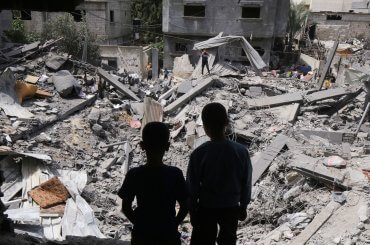Many people have sent me raves about Chris Hedges’s appearance the other night at the Gaza boat fundraiser. They have praised his work on the issue, in particular his 2001 Harper’s piece, A Gaza Diary. It included the stunning scene below. We will make no progress in American policymaking till we acknowledge the atrocities against the Palestinians (and American atrocities in Iraq and Afghanistan). These stories are, after all, repeated across the Arab world, and they are not myths. Yes this story is before the settlements were removed from Gaza, but the disdain for Palestinian life, that is what Goldstone documented. And NPR wants us to suppress the Goldstone report! Hedges:
I sit in the shade of a palm-roofed hut on the edge of the dunes, momentarily defeated by the heat, the grit, the jostling crowds, the stench of the open sewers and rotting garbage. A friend of Azmi’s brings me, on a tray, a cold glass of tart, red carcade juice.
Barefoot boys, clutching kites made out of scraps of paper and ragged soccer balls, squat a few feet away under scrub trees. Men in flowing white or gray galabias—homespun robes—smoke cigarettes in the shade of slim eaves. Two emaciated donkeys, their ribs protruding, are tethered to wooden carts with rubber wheels. / It is still. The camp waits, as if holding its breath. And then, out of the dry furnace air, a disembodied voice crackles over a loudspeaker.
"Come on, dogs," the voice booms in Arabic. "Where are all the dogs of Khan Younis? Come! Come!" / I stand up. I walk outside the hut. The invective continues to spew: "Son of a bitch!" "Son of a whore!" "Your mother’s cunt!"
The boys dart in small packs up the sloping dunes to the electric fence that separates the camp from the Jewish settlement. They lob rocks toward two armored jeeps parked on top of the dune and mounted with loudspeakers. Three ambulances line the road below the dunes in anticipation of what is to come.
A percussion grenade explodes. The boys, most no more than ten or eleven years old, scatter, running clumsily across the heavy sand. They descend out of sight behind a sandbank in front of me. There are no sounds of gunfire. The soldiers shoot with silencers. The bullets from the M-16 rifles tumble end over end through the children’s slight bodies. Later, in the hospital, I will see the destruction: the stomachs ripped out, the gaping holes in limbs and torsos.
Yesterday at this spot the Israelis shot eight young men, six of whom were under the age of eighteen. One was twelve. This afternoon they kill an eleven-year-old boy, Ali Murad, and seriously wound four more, three of whom are under eighteen. Children have been shot in other conflicts I have covered—death squads gunned them down in El Salvador and Guatemala, mothers with infants were lined up and massacred in Algeria, and Serb snipers put children in their sights and watched them crumple onto the pavement in Sarajevo—but I have never before watched soldiers entice children like mice into a trap and murder them for sport.
We approach a Palestinian police post behind a sand hill. The police, in green uniforms, are making tea. They say that they have given up on trying to hold the children back.
"When we tell the boys not to go to the dunes they taunt us as collaborators," Lt. Ayman Ghanm says. "When we approach the fence with our weapons to try and clear the area the Israelis fire on us. We just sit here now and wait for the war."

